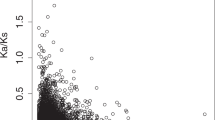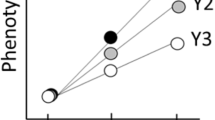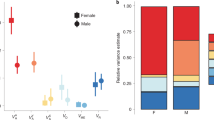Abstract
The equilibrium per-genome mutation rate in sexual species is thought to result from a trade-off between the benefits of reducing the deleterious mutation rate and the costs of increasing fidelity1,2. We propose that selection will often favour a lower mutation rate on the X chromosome than on autosomes, owing to the exposure of deleterious recessive mutations on hemizygous chromosomes. We tested this hypothesis by examining 33 X-linked genes that have been sequenced in both mouse and rat, and compared their rate of evolution against 238 autosomal genes. The X-linked genes were found to have a significantly lower rate of synonymous substitution than the autosomal genes. Neither the supposed higher mutation rate in males nor stronger purifying selection against slightly deleterious mutations on the X chromosome can account for the low value. The most parsimonious explanation is that rodents have a lower mutation rate on the X chromosome than on autosomes. It is therefore likely that previous indirect estimates of the excess male mutation rate are inaccurate. Indeed, after correction we find no evidence for a male-biased mutation rate in rodents. Furthermore, the rate of synonymous substitution in Y-linked genes is not significantly different from that in autosomal ones. The extent to which enhanced male mutation rates are problematic3 for the mutational deterministic model4 of the evolution of sex must, in turn, be questioned.
This is a preview of subscription content, access via your institution
Access options
Subscribe to this journal
Receive 51 print issues and online access
$199.00 per year
only $3.90 per issue
Buy this article
- Purchase on Springer Link
- Instant access to full article PDF
Prices may be subject to local taxes which are calculated during checkout
Similar content being viewed by others
References
Leigh, E. G. Natural selection and mutability. Am. Nat. 104, 301–305 (1970).
Kondrashov, A. S. Modifiers of mutation-selection balance: general-approach and the evolution of mutation-rates. Genet. Res. 66, 53–69 (1995).
Redfield, R. J. Male mutation rates and the cost of sex for females. Nature 369, 145–147 (1994).
Kondrashov, A. S. Deleterious mutations and the evolution of sexual reproduction. Nature 336, 435–440 (1988).
Kimura, M. On the evolutionary adjustment of mutation rates. Genet. Res. 9, 23–34 (1967).
Miyata, T., Hayashida, H., Kuma, K., Mitsuyasu, K. & Yasunaga, T. Male-driven molecular evolution: a model and nucleotide sequence analysis. Cold Spring Harb. Symp. Quant. Biol. 52, 863–867 (1987).
Chang, B. H. J., Shimmin, L. C., Shyue, S. K., Hewett-Emmett, D. & Li, W.-H. Weak male-driven molecular evolution in rodents. Proc. Natl Acad. Sci. USA 91, 827–831 (1994).
Chang, B. H. J. & Li, W.-H. Estimating the intensity of male-driven evolution in rodents by using X-linked and Y-linked Ube-1 genes and pseudogenes. J. Mol. Evol. 40, 70–77 (1995).
Bulmer, M. G. Principles of Statistics (Dover, New York, 1979).
Shimmin, L. C., Chang, B. H. J., Hewett-Emmett, D. & Li, W.-H. Potential problems in estimating the male-to-female mutation-rate ratio from DNA-sequence data. J. Mol. Evol. 37, 160–166 (1993).
Li, W.-H. Models of nearly neutral mutations with particular implications for nonrandom usage of synonymous codons. J. Mol. Evol. 24, 337–345 (1987).
Crow, J. F. & Simmonds, M. J. in The Genetics and Biology of Drosophila (eds Ashburner, M., Carson, H. L. & Thompson, J. N.) 1–35 (Academic, London, 1983).
Wolfe, K. H. & Sharp, P. M. Mammalian gene evolution: nucleotide sequence divergence between mouse and rat. J. Mol. Evol. 37, 441–456 (1993).
Sharp, P. M. in Evolution and Animal Breeding: Reviews on Molecular and Quantitative Approaches in Honour of Alan Robertson (eds Hill, W. G. & Mackay, T. F. C.) 24–32 (CAB International, Wallingford, UK, 1989).
Wolfe, K. H., Sharp, P. M. & Li, W.-H. Mutation rates differ among regions of the mammalian genome. Nature 337, 283–285 (1989).
Eyre-Walker, A. An analysis of codon usage in mammals: selection or mutation bias? J. Mol. Evol. 33, 442–449 (1991).
Ohta, T. An examination of the generation time effect on molecular evolution. Proc. Natl Acad. Sci. USA 90, 10676–10680 (1993).
Li, W.-H., Ellsworth, D. L., Krushkal, J., Chang, B. H. J. & Hewett-Emmett, D. Rates of nucleotide substitution in primates and rodents and the generation time effect hypothesis. Mol. Phylogen. Evol. 5, 182–187 (1996).
Charlesworth, B. The effect of background selection against deleterious mutations on weakly selected, linked variants. Genet. Res. 63, 213–227 (1994).
Charlesworth, B., Coyne, J. A. & Barton, N. H. The relative rates of evolution of sex chromosomes and autosomes. Am. Nat. 130, 113–146 (1987).
Jeffreys, A. J. et al. Complex gene conversion events in germline mutation at human minisatellites. Nature Genet. 6, 136–145 (1994).
Ketterling, R. P. et al. Germ-line origins of mutation in families with hemophilia-B: the sex-ratio varies with the type of mutation. Am. J. Hum. Genet. 52, 152–166 (1993).
Driscoll, D. J. & Migeon, B. R. Sex difference in methylation of single-copy genes in human meiotic germ-cells-implications for X-chromosome inactivation, parental imprinting, and origin of CpG mutations. Somat. Cell Mol. Genet. 16, 267–282 (1990).
Hurst, L. D. & Peck, J. R. Recent advances in understanding of the evolution and maintenance of sex. Trends Ecol. Evol. 11, A46–A52 (1996).
Gillespie, J. H. On Ohta's hypothesis: most amino acid substitutions are deleterious. J. Mol. Evol. 40, 64–69 (1995).
Mouse Genome Database 3.1, Mouse Genome Informatics (Jackson Laboratory, Bar Harbor, ME, 1996). URL:http://www.informatics.jax.org/.
Altschul, S. F., Gish, W., Miller, W., Myers, E. W. & Lipman, D. J. Basic local alignment search tool. J. Mol. Biol. 215, 403–410 (1990).
GCG Wisonsin Package Version 8, manual (Genetics Computer Group, Madison, WI, 1994).
Li, W.-H., Wu, C.-I. & Luo, C.-C. A new method for estimating synonymous and non-synonymous rates of nucelotide substitution considering the relative likelihood of nucleotide and codon changes. Mol. Biol. Evol. 2, 150–174 (1985).
Li, W.-H. Unbiased estimation of the rates of synonymous and nonsynonymous substitution. J. Mol. Evol. 36, 96–99 (1993).
Author information
Authors and Affiliations
Rights and permissions
About this article
Cite this article
McVean, G., Hurst, L. Evidence for a selectively favourable reduction in the mutation rate of the X chromosome. Nature 386, 388–392 (1997). https://doi.org/10.1038/386388a0
Received:
Accepted:
Issue Date:
DOI: https://doi.org/10.1038/386388a0
This article is cited by
-
Single genome retrieval of context-dependent variability in mutation rates for human germline
BMC Genomics (2017)
-
Evidence of non-random mutation rates suggests an evolutionary risk management strategy
Nature (2012)
-
Mutation rate variation in multicellular eukaryotes: causes and consequences
Nature Reviews Genetics (2007)
-
Enhanced adaptive evolution of sperm-expressed genes on the mammalian X chromosome
Heredity (2006)
-
Evolution on the X chromosome: unusual patterns and processes
Nature Reviews Genetics (2006)
Comments
By submitting a comment you agree to abide by our Terms and Community Guidelines. If you find something abusive or that does not comply with our terms or guidelines please flag it as inappropriate.



